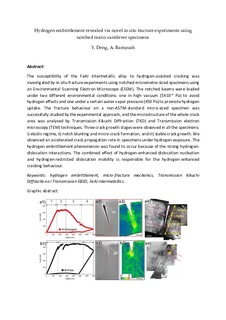| dc.contributor.author | Deng, Yun | |
| dc.contributor.author | Barnoush, Afrooz | |
| dc.date.accessioned | 2018-03-22T08:32:35Z | |
| dc.date.available | 2018-03-22T08:32:35Z | |
| dc.date.created | 2017-09-27T13:17:03Z | |
| dc.date.issued | 2018 | |
| dc.identifier.citation | Acta Materialia. 2018, 142 236-247. | nb_NO |
| dc.identifier.issn | 1359-6454 | |
| dc.identifier.uri | http://hdl.handle.net/11250/2491604 | |
| dc.description.abstract | The susceptibility of the FeAl intermetallic alloy to hydrogen-assisted cracking was investigated by in situ fracture experiments using notched micrometre-sized specimens using an Environmental Scanning Electron Microscope (ESEM). The notched beams were loaded under two different environmental conditions: one in high vacuum (5 × 10−4 Pa) to avoid hydrogen effects and one under a certain water vapor pressure (450 Pa) to promote hydrogen uptake. The fracture behaviour on a non-ASTM-standard micro-sized specimen was successfully studied by the experimental approach, and the microstructure of the whole crack area was analysed by Transmission Kikuchi Diffraction (TKD) and Transmission electron microscopy (TEM) techniques. Three crack growth stages were observed in all the specimens: i) elastic regime, ii) notch blunting and micro-crack formation; and iii) stable crack growth. We observed an accelerated crack propagation rate in specimens under hydrogen exposure. The hydrogen embrittlement phenomenon was found to occur because of the strong hydrogen-dislocation interactions. The combined effect of hydrogen-enhanced dislocation nucleation and hydrogen-restricted dislocation mobility is responsible for the hydrogen-enhanced cracking behaviour. | nb_NO |
| dc.language.iso | eng | nb_NO |
| dc.publisher | Elsevier | nb_NO |
| dc.relation.uri | http://www.sciencedirect.com/science/article/pii/S1359645417308273 | |
| dc.title | Hydrogen embrittlement revealed via novel in situ fracture experiments using notched micro-cantilever specimens | nb_NO |
| dc.type | Journal article | nb_NO |
| dc.description.version | submittedVersion | nb_NO |
| dc.source.pagenumber | 236-247 | nb_NO |
| dc.source.volume | 142 | nb_NO |
| dc.source.journal | Acta Materialia | nb_NO |
| dc.identifier.doi | 10.1016/j.actamat.2017.09.057 | |
| dc.identifier.cristin | 1498908 | |
| dc.relation.project | NORTEM: 197405 | nb_NO |
| dc.relation.project | Norges forskningsråd: 244068/E30 | nb_NO |
| dc.description.localcode | This is a submitted manuscript of an article published by Elsevier Ltd in Acta Materialia, 26 September 2017. | nb_NO |
| cristin.unitcode | 194,64,92,0 | |
| cristin.unitname | Institutt for maskinteknikk og produksjon | |
| cristin.ispublished | true | |
| cristin.fulltext | preprint | |
| cristin.qualitycode | 2 | |
